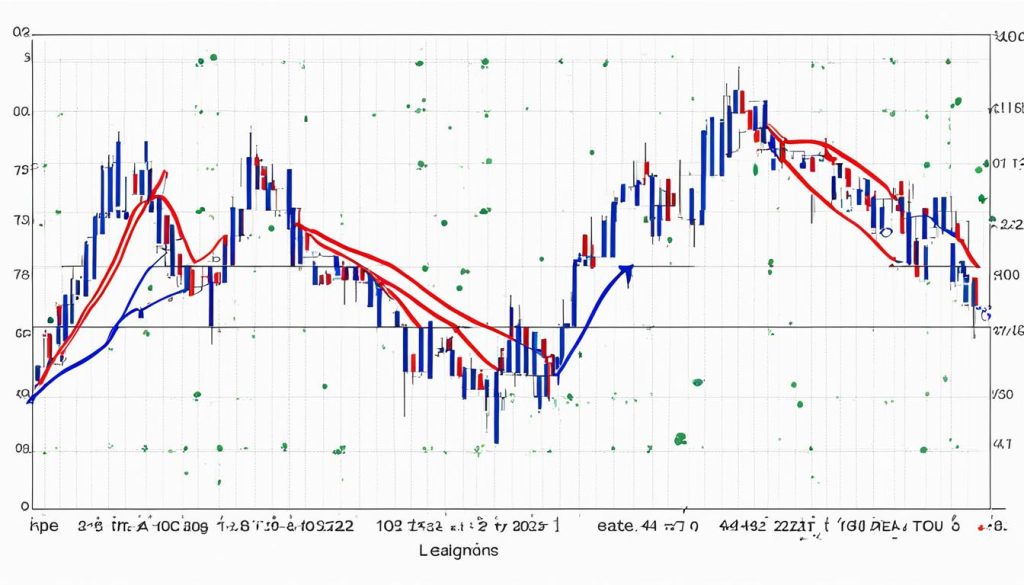The Elliott wave sage is a broad and intricate concept of market analysis that reveals how financial markets move in recognizable patterns. A key component of this theory is the leading diagonal Elliott wave, a complex yet pivotal pattern for those seeking to master the art of wave analysis. This diagonal wave pattern not only provides insight into market trends but also serves as a beacon for predicting future market directions.
Delving into the intricate world of the Elliott wave calculation, we find the leading diagonal as an opening act in the grand play of market movements. It often signals the beginning of a significant price change, making its identification a critical skill for any astute analyst. By interweaving theory and practice, the leading diagonal carves a distinct niche in the annals of Elliott wave theory.
What is a Leading Diagonal Elliott Wave?
The leading diagonal formation serves as the cornerstone for traders seeking to navigate the ebbs and flows of the financial markets. As an integral component of Elliott Wave Theory, the leading diagonal Elliott wave is acknowledged for its capacity to signal the initiation of a new trend. Contrary to conventional impulse waves, this leading diagonal pattern is marked by a distinctive diagonal wave structure, ushering in waves of change.
Characteristics of Leading Diagonal Waves
A leading diagonal is typically observed at the onset of a wave sequence, often materializing in Wave 1 or Wave A positions. It is composed of five sub-waves that emanate with the prevailing trend while exhibiting an overlapping occurrence between the first and fourth waves. This leading diagonal pattern leans towards two distinct configurations:
- Contracting Leading Diagonal: Characterized by a progressively shorter wave length as the pattern develops towards the apex.
- Expanding Leading Diagonal: This variation displays an incremental increase in wave length, expanding towards the conclusion of the pattern.
The precise understanding of these characteristics is essential for proficient trading decisions, as the emergence of a leading diagonal pattern can often prelude a vigorous market reversal.
Role in Technical Analysis and Trading
For the technical analyst, the lead diagonal’s unique structure is a beacon, signaling potential turning points in market conditions. It offers a preemptive glimpse into major shifts in market sentiment, setting the stage for subsequent price movements that align with the overarching trend. Traders capitalize on the predictable nature of this pattern, harnessing it to refine entry and exit strategies for optimized performance in the markets.
| Leading Diagonal Type | Characteristics | Trend Indication |
|---|---|---|
| Contracting | Shortening waves, Overlap between waves 1 and 4 | Potential for a sharp reversal following completion |
| Expanding | Lengthening waves, Overlap between waves 1 and 4 | Indication of strong continuation of current trend |
The Anatomy of a Leading Diagonal
Grasping the intricate diagonal wave pattern in the leading diagonal Elliott wave is pivotal for adept wave counting. Traders and analysts seek to understand its unique formation that often uses a 3-3-3-3-3 or a 5-3-5-3-5 internal wave structure. This construction is not only fundamental in identifying market cycles, it also illuminates potential future market movements.
Within the compelling architecture of a leading diagonal, wave two is known to enact a sharp reversal, correcting nearly all of wave one’s progress, falling short of exceeding the origin point. Such insightful aspects within diagonal wave patterns provide analysts with a deeper understanding of market sentiment and potential shifts. Wave four follows, strictly not overlapping the terminal point of wave two, maintaining the integrity of the structure. Recognizing these nuances is critical to maximizing the potential of Elliott wave analysis.
| Wave | Typical Correction | Overlap Specifications | Contracting vs Expanding |
|---|---|---|---|
| Wave 1 | – | Must not be surpassed by Wave 2 | Beginning of Contracting Diagonal |
| Wave 2 | Up to 99% of Wave 1 | Must not surpass the origin of Wave 1 | – |
| Wave 3 | – | Must not be the shortest wave | Occurs within both diagonals |
| Wave 4 | – | Must not overlap end of Wave 2 | Ending of Expanding Diagonal |
The classification into either a contracting or an expanding diagonal elucidates the tendency of leading diagonals to form with distinct pacing. In contracting diagonals, the journey begins with the longest wave, only to gradually dwindle in size, whereas expanding diagonals unleash a crescendo, with the longest surge occurring at the culmination of the pattern. Mastery of these leading diagonal structures is instrumental for investors and traders who rely on wave analysis for market prediction and strategy formulation.
Comparing Leading Diagonals and Traditional Impulse Waves
Unraveling the intricacies of the Elliott wave principle leads to a profound understanding of how leading diagonal Elliott waves differ significantly from traditional impulse waves. Known for their exceptional structure within the wave analysis domain, leading diagonal waves present attributes that are pivotal in chart analysis and forecasting. We delve into the unique complexities associated with these wave patterns, illuminating their place within the broader context of financial market fluctuations.
Overlap Between Waves One and Four
In the realm of the Elliott wave principle, the overlap between waves one and four is a hallmark of the leading diagonal Elliott wave. Unlike the neat progression seen in impulse waves, the diagonal wave pattern permits this overlap, providing a visual indicator of a leading diagonal formation to the astute observer. This characteristic is a definitive criterion distinguishing leading diagonals in wave analysis.
Motive Wave Variations Within Diagonals
Focusing on diagonal wave patterns, it’s evident that motive wave variations manifest uniquely within leading diagonals. They encapsulate a more complex mix of zigzag and at times, impulse substructures that contribute to the nuanced shape of the overall wave formation. With these subtleties, proficiency in wave counting becomes a critical skill for practitioners striving to capitalize on the predictive power of the Elliott wave principle.
| Characteristic | Leading Diagonal Wave | Traditional Impulse Wave |
|---|---|---|
| Wave Overlap | Waves one and four overlap | No overlap between waves |
| Wave Structure | Often a 3-3-3-3-3 or 5-3-5-3-5 internal structure | Typically a 5-3-5-3-5 structure with no overlaps |
| Occurrence in Trend | Begins new trends with wave A or 1 | Occurs throughout trend as part of the motive sequence |
| Sub-wave Composition | Impulses or zigzags | Mostly impulses |
Real-World Applications of Leading Diagonal Waves
The practical implementation of leading diagonal patterns in trading is a testament to the robust framework of wave analysis offered by the Elliott wave principle. Seasoned traders are adept at identifying the diagonal wave structure on market charts, enabling them to position their trades in alignment with projected market swings. This form of analysis is not a mere academic exercise but a vital strategic tool used daily in trading rooms across the globe.
Identifying Leading Diagonals in Market Charts
Discerning a leading diagonal pattern on a market chart necessitates a meticulous approach. Traders probe the signature overlaps and internal subdivisions of the leading diagonal pattern to classify and anticipate potential market movements. This heightened level of scrutiny allows traders to distinguish between a genuine leading diagonal formation and a more simplistic corrective or impulse sequence. The validity of such a pattern is further confirmed as it evolves, which often calls for a strategic adjustment to optimize entry and exit points.
Practical Examples and Case Studies
Historical case studies serve as solid indicators of how leading diagonals have signaled monumental shifts in trend dynamics and have been imperative in strategizing before significant market events. A notable instance of this occurred during the Brexit negotiations, where astute wave analysis revealed leading diagonals that came to fruition in volatile price gyrations. Such examples underscore the relevance of integrating leading diagonal patterns into trading methodologies to capably navigate the markets’ ebbs and flows.
FAQ
A Leading Diagonal Elliott Wave is a specific type of wave pattern identified in Elliott Wave Theory which signifies the start of a new trend phase. It is characterized by a five-wave structure in which there is an overlap between waves one and four, often seen in the first or A waves of an impulse or corrective sequence. This pattern exhibits a unique formation compared to the typical motive waves in Elliott Wave Theory.
The characteristics of a leading diagonal include a five-wave internal structure where waves two and four correct, but do not surpass the origin points of waves one and three, respectively. Wave three is never the shortest. Diagonals can be contracting, with the longest wave at the start, or expanding, with the wave lengths increasing over time. This pattern can include a structure composed of 3-3-3-3-3 or 5-3-5-3-5 internal wave counts.
The leading diagonal differs from traditional impulse waves because it allows for an overlap between waves one and four, which is not found in standard impulse waves that follow a 5-3-5-3-5 structure without overlapping. Furthermore, leading diagonals can exhibit different internal wave structures, such as zigzags or occasionally impulses, adding a layer of complexity to wave analysis and interpretation.
In technical analysis and trading, leading diagonals serve as indicators of the beginning of a new trend or the start of a correction phase. Traders look for these patterns to predict market reversals and the subsequent continuation of trends. Effective identification and analysis of leading diagonals allow traders to position their trades in anticipation of these movements.
Leading diagonals are identified in market charts through careful observation and wave counting. Traders analyze chart structures to spot the distinctive overlap between waves one and four and the internal wave pattern that adheres to the rules of a leading diagonal. Verifying their formation through additional price movements is essential before considering them in trading strategy adjustments.






